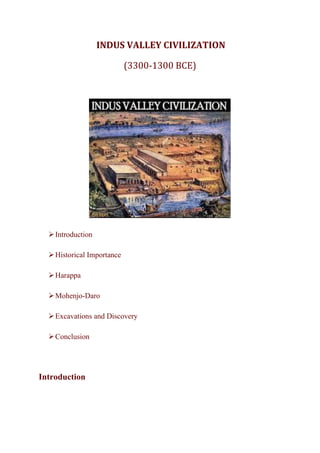
Indus Valley Civilization
- 1. INDUS VALLEY CIVILIZATION (3300-1300 BCE) ➢Introduction ➢Historical Importance ➢Harappa ➢Mohenjo-Daro ➢Excavations and Discovery ➢Conclusion Introduction
- 2. The first recognised urban civilisation on the Indian subcontinent is the Indus valley civilization, commonly referred to as the Indus civilization or Harappan civilization. Although the southern sites may have persisted later into the second millennium BCE, the civilization's nuclear dates appear to be between 250 to 1700 BCE. Three distinct periods—the Early Harappan Phase (3300-2600 BCE), Mature Harappan Phase (2600-1900 BCE), and Late Harappan Phase—are frequently used to describe the Indus Valley Civilization's existence (1900-1300 BCE). Historical Importance The Indus Valley Civilization is also among the most well-known of the three "Ancient East" societies—Mesopotamia and Pharaonic Egypt are the other two—that are thought to represent the origins of civilization in the old world of man. The Indus Valley Civilization thrived from 3300 to 1300 BCE in its early years and from 2600 to 1900 BCE in its prime years. This civilization's domain stretched from what is now northeast Afghanistan through Pakistan and northwest India along the Indus River. Of the three early civilizations of the ancient world—Ancient Egypt, Mesopotamia, and the Indus—the Indus Civilization was the most extensive. When the Indus Valley Civilization first appeared approximately 2600 BCE along the Indus River Valley in the Sindh and Punjab provinces of Pakistan, Harappa and Mohenjo-Daro were considered to be its two greatest towns. Important archaeological information on ancient societies was obtained through their discovery and excavation in the 19th and 20th centuries. The Indus Valley Civilization may have had over five million
- 3. people living in it at its height. It is regarded as a Bronze Age civilization, and people who lived in the historic Indus River Valley created new methods for working with metals like copper, bronze, lead, and tin. They also engaged in elaborate craftsmanship, particularly with items made of the semi-precious stone carnelian, and seal carving, which involves engraving designs onto a seal's bottom face for use in stamping. The Indus cities are renowned for their masterful urban planning, baked brick homes, intricate water supply and drainage systems, and groups of substantial non-residential structures. Harappa In addition, Harappa, a walled city in present-day Pakistan, is said to have been home to up to 23,500 people who lived in sculpted buildings with flat roofs constructed of red sand and clay. The city contained fortified administrative and religious centres similar to those found in Mohenjo- Daro, and it covered an area of 150 hectares (370 acres). The ancient city site, which sustained significant damage during the British era of control, lies six kilometres (3.7 miles) from the contemporary settlement of Harappa, which served as a railway station during the Raj. Charles Masson published the earliest account of the remains of Harappa in his book Narrative of Various Journeys in Balochistan, Afghanistan, the Panjab, & Kalât in 1842. British engineers John and William Brunton were building the East Indian Railway Company line between Karachi and Lahore in 1856 when their workers unknowingly destroyed the ruins of the ancient city of Brahminabad by using nearby hard, well-burned bricks as ballast for the railroad track.
- 4. Mohenjo-Daro In addition, Mohenjo-Daro, which is believed to have been founded in the 26th century BCE, was not only the largest metropolis of the Indus Valley Civilization but also one of the first significant urban centres in the entire world. Mohenjo-Daro, which was one of the most advanced cities of its time with complex engineering and urban planning, was situated west of the Indus River in the Larkana District. Domesticated chickens were bred for religion rather than sustenance, and cockfighting was believed to have religious and ritual significance (although the city may have been a point of origin for the worldwide domestication of chickens). Around 1900 BCE, when the Indus Civilization abruptly collapsed, Mohenjo-Daro was abandoned. Excavations and Discovery
- 5. Several Harappan seals were also found in 1912 by English government worker John Faithfull Fleet, who was employed by the Indian Civil Services. As a result, Sir John Hubert Marshall, Director-General of the Archaeological Survey of India, launched an excavation expedition in 1921– 1922, which led to the discovery of Harappa. Mohenjo-Daro had been extensively excavated by 1931, and Sir Mortimer Wheeler, the second director of the Archaeological Survey of India, oversaw additional work. Conclusion As a result, unlike their contemporaries, the inhabitants of this Indus Valley civilization did not erect large monuments or bury valuables among the dead in golden graves. In their region, there were no emperors, tombs, gory conflicts, or deadly wars. The people of the Indus Valley were supporting the ordinary, secular, living people pragmatically. Yes, they practised social stratification and believed in the afterlife. However, they also thought that resources had more value when they were shared among the living rather than being on display or buried deep down. Ultimately, the partition of India in 1947 resulted in the creation of the new country of Pakistan. Pakistan inherited the majority of the ensuing archaeological discoveries. Over 1,056 cities and communities had been discovered by 1999, 96 of which had been excavated. For More Articles Check This...